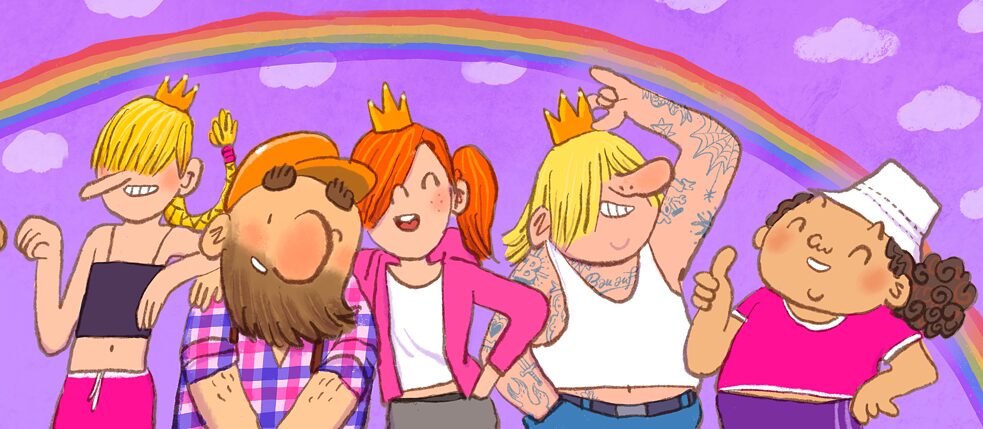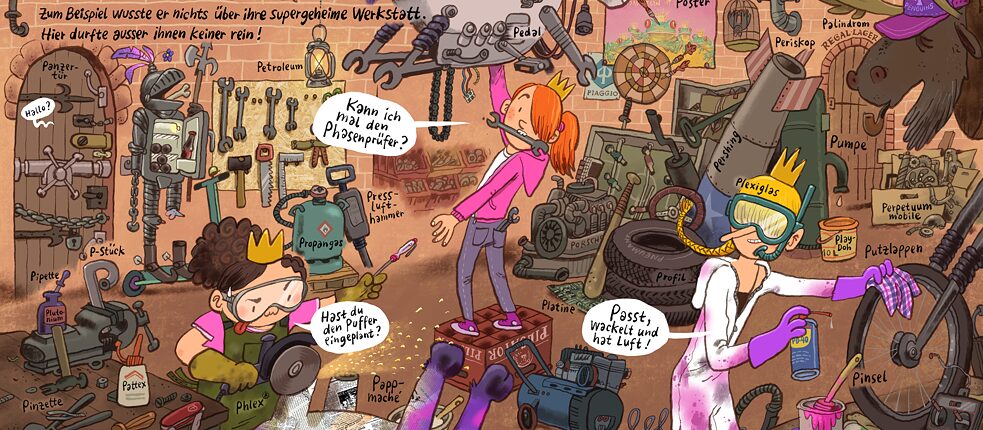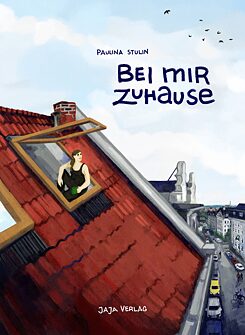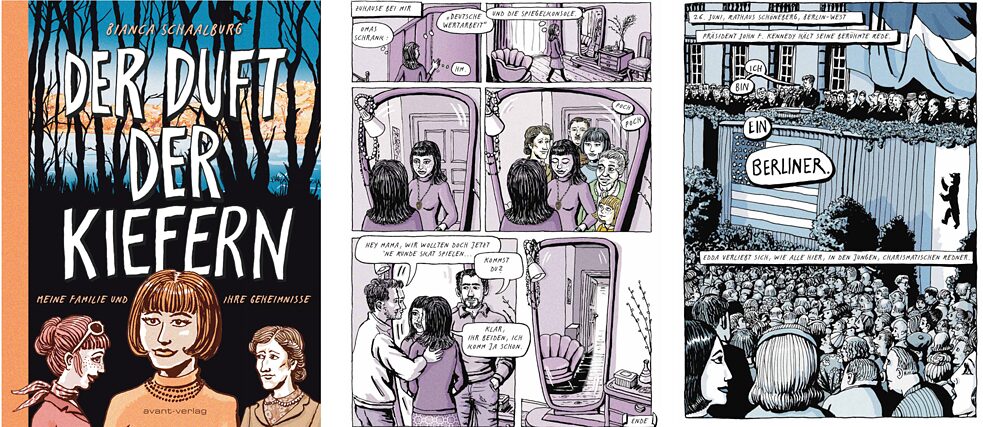Trends in German Comics 2021
Continuity and a love of storytelling

Not only has the comic scene in Germany become more diverse and professional, the genre is also becoming increasingly popular with readers. From children’s comics to the corona diary – the trends in 2021.
By Ralph Trommer
Whilst in recent years we watched in astonishment as an increasing number of artists turned to the comic as an art form, we can now confirm that the medium has been accorded more of a professional status in both narrative and visual terms as a consequence – and it’s also becoming increasingly popular with readers.
This is becoming particularly apparent in the field of kids’ comics, for example. Whereas a few years ago there were only a few examples of successful comics for children and young people – including for instance Q-R-T, the friendly alien story by Ferdinand Lutz, which has amassed several volumes to date – more and more specialist publishers are now discovering this narrative form. Because of this, Reprodukt, Kibitz Verlag and new labels like Egmont Bäng! and the forthcoming graphix comic from Loewe, are also opening up new platforms for illustrators. The result is that new, exciting and funny stories are created, which are then professionally accomplished.
 In “Power Prinzessinnen Patrouille” (Power Princesses Patrol), illustrator Markus Witzel plays skilfully with gender clichés.
| Photo (detail): © Mawil/Reprodukt 2021
The comic Zack! by author Volker Schmitt and illustrator Màriam Ben-Arab is a lovely example of the new light-hearted narrative style for children, which combines day-to-day life with pirate adventure. On top of that there is a likeable, diverse role model in the shape of Bonny, a girl with dark skin, who appeals equally to both boys and girls. The famous Berlin illustrator Mawil, Markus Witzel, also addresses the children’s literature market with two new books: in Power Prinzessinnen Patrouille (Power Princesses Patrol) and Mauer, Leiter, Bauarbeiter (Wall, Ladder, Builder), he plays skilfully with gender clichés and brings some magic into the words with witty use of alliteration.
In “Power Prinzessinnen Patrouille” (Power Princesses Patrol), illustrator Markus Witzel plays skilfully with gender clichés.
| Photo (detail): © Mawil/Reprodukt 2021
The comic Zack! by author Volker Schmitt and illustrator Màriam Ben-Arab is a lovely example of the new light-hearted narrative style for children, which combines day-to-day life with pirate adventure. On top of that there is a likeable, diverse role model in the shape of Bonny, a girl with dark skin, who appeals equally to both boys and girls. The famous Berlin illustrator Mawil, Markus Witzel, also addresses the children’s literature market with two new books: in Power Prinzessinnen Patrouille (Power Princesses Patrol) and Mauer, Leiter, Bauarbeiter (Wall, Ladder, Builder), he plays skilfully with gender clichés and brings some magic into the words with witty use of alliteration.
Family histories and covid experiences
 In “Bei mir zuhause” (At My House), Paulina Stulin draws on her own life.
| Photo: © Heike Dietz
Gender roles, identities and personal experiences play a part in many graphic novels for adults too: comic writers process experiences from their own lives or reflect on the history of their own families. In Bei mir zuhause (At My House), Paulina Stulin draws on her own life to create detailed illustrations depicting dance, sex, good conversations and frustrating experiences. In Fürchtetal (Valley of Fear), Markus Färber finds nightmarishly beautiful images through which to tell the story of his father’s depression and suicide based on the poetic letters sent by his sister Christine Färber. Bianca Schaalburg on the other hand painstakingly comes to terms with suppressed chapters in her own family’s history in Der Duft der Kiefern (The Fragrance of the Pines), which draws readers into the Nazi era.
In “Bei mir zuhause” (At My House), Paulina Stulin draws on her own life.
| Photo: © Heike Dietz
Gender roles, identities and personal experiences play a part in many graphic novels for adults too: comic writers process experiences from their own lives or reflect on the history of their own families. In Bei mir zuhause (At My House), Paulina Stulin draws on her own life to create detailed illustrations depicting dance, sex, good conversations and frustrating experiences. In Fürchtetal (Valley of Fear), Markus Färber finds nightmarishly beautiful images through which to tell the story of his father’s depression and suicide based on the poetic letters sent by his sister Christine Färber. Bianca Schaalburg on the other hand painstakingly comes to terms with suppressed chapters in her own family’s history in Der Duft der Kiefern (The Fragrance of the Pines), which draws readers into the Nazi era.
The coronavirus crisis has also given rise to multiple reflections in illustrated form. In her book Corona Diaries, Jutta Bauer documents the new lifestyle forced upon people by the pandemic. Ralf König lives vicariously through his characters, gay couple Konrad and Paul, as they experience viral times in Vervirte Zeiten.
Comic exhibitions are being held more frequently and are often pitched as community shows, like Unveröffentlicht – Die Comicszene packt aus! (Unpublished – the comic scene unwrapped) in the Ludwiggalerie art museum in Oberhausen, where new comics are set alongside classics such as Wilhelm Busch or e.o. plauen and there is a focus on projects in progress.
 Bianca Schaalburg comes to terms with suppressed chapters in her own family’s history in “Der Duft der Kiefern” (The Fragrance of the Pines), which draws readers into the Nazi era.
| Photo (detail): © Schaalburg/Avant 2021
Bianca Schaalburg comes to terms with suppressed chapters in her own family’s history in “Der Duft der Kiefern” (The Fragrance of the Pines), which draws readers into the Nazi era.
| Photo (detail): © Schaalburg/Avant 2021
History in the comic book
In book form there are thematically ambitious anthologies such as Nächstes Jahr in (Next Year In), in which comic illustrators look at Jewish culture, history and Jewish biographies in Germany, taking a broad approach in both style and content. The comic has also now proved successful as a means of illustrating complex historical themes and biographies, and in the best-case scenario revamping them into a condensed and enlightening format. Kristina Gehrmann for instance has dedicated her life to the British queen Mary Tudor alias Bloody Mary, drawing her with big manga eyes and in bright colours.
In Goldjunge – Beethovens Jugendjahre (Golden Boy – Beethoven’s Teen Years), Mikael Ross turns out to be an accomplished storyteller whose illustrations are based on original and brilliant ideas – for example to visualise music. And in Der Kaiser im Exil (The Emperor in Exile) Jan Bachmann creates a loosely ironic profile of the late Wilhelm II, who fled into Dutch exile after the First World War. In style terms Bachmann fluctuates between abstraction and “expressionist slapstick”. Someone else who could be considered equally adventurous and artistically unconventional is Anna Haifisch, who in The Artist-Ode an die Feder faces up to her alter ego “The Artist” in a poetic way and smugly sends up the art industry in the process.